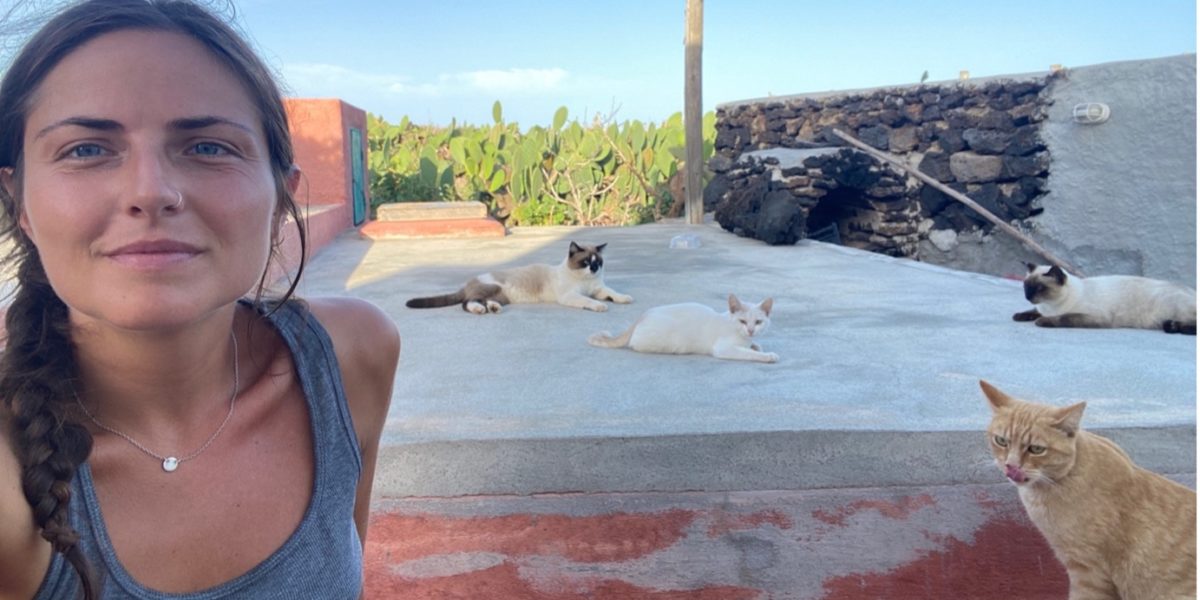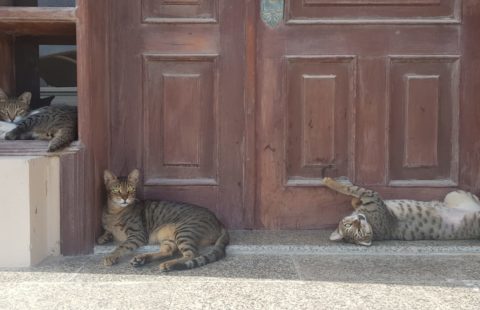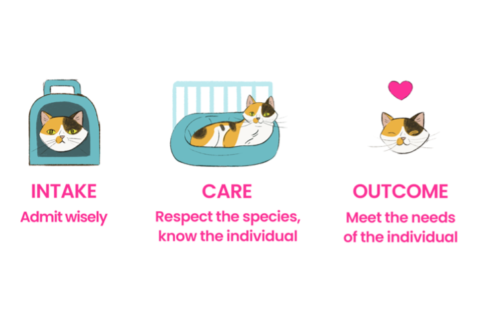Vicky Halls, Head of Unowned Cats at International Cat Care, met Martina Cecchetti in 2020 when she and Sarah Ellis (Head of Cat Mental Wellbeing and Behaviour) attended a meeting at the University of Exeter on ‘Cats in the environment’.
It was a great opportunity for people from the cat, bird and wildlife world to get together in a positive way to consider the impact of cat predation in the UK.
Vicky interviewed Martina (pictured above, all images copyright Martina Cecchetti) about her work on Linosa, an island in the Mediterranean Sea and a biodiversity hotspot for migratory birds. Vicky was fascinated to know how Martina, and the people she works with, tackle the balance between cat population management, predation and the protection of the island’s biodiversity. This is their conversation…
Martina, tell us a little bit about your background…
I am a wildlife and companion animal ecologist. Specifically, I have a bachelor’s degree in biology, a masters in Evolution of Animal and Human Behaviour, and a PhD in biology with a thesis on the ecology and management of predation of wildlife by domestic cats. I am also vice president of Berta maris – a non-profit association devoted to the conservation and protection of island biodiversity, managing the Cat Trap-Neuter-Return Programme in Linosa Island (a small island situated between Sicily and Africa). My research has always been focused on cats and their hunting behaviour, particularly finding solutions that could be a win-win for both cats and wild fauna. I am also studying to become a cat behaviourist one day, so I would say that I love cats to bits!
How did you come to be working with the cats on Linosa?
In my masters class, I met Giulia, a girl that used to go to Linosa each year to monitor the Scopoli’s shearwaters nesting there. I became fascinated by her stories and by the shearwaters themselves, so in August 2013, I went to Linosa with her. Once there, I participated in the fieldwork for monitoring shearwater chicks, but I could not help myself, and I started to take care of and feed the numerous free-roaming cats living just outside our house. So, Giacomo (an ornithologist and the so-called shearwater boss), noticed my interest in cats and he proposed that I write my thesis on their feeding ecology and finding a solution to tackle the problem of predation upon shearwaters.
What can you tell us about the cats on Linosa when you first visited?
When I first arrived there, the cat situation was completely out of control. There were unneutered cats and kittens everywhere and in very poor health. Imagine that in front of the pharmacy, there was a colony of at least 30 cats, eating and doing their business just on the pavement – the same was in front of the fish shop! I have to say that the situation was concerning, not only for cat welfare but also from a human hygiene perspective. The islanders loved cats, especially for their role in keeping the rodent population under control, but there were so many cats that could not be fed or taken care of properly, so they used to give them kitchen leftovers – not really appropriate for obligate carnivores!
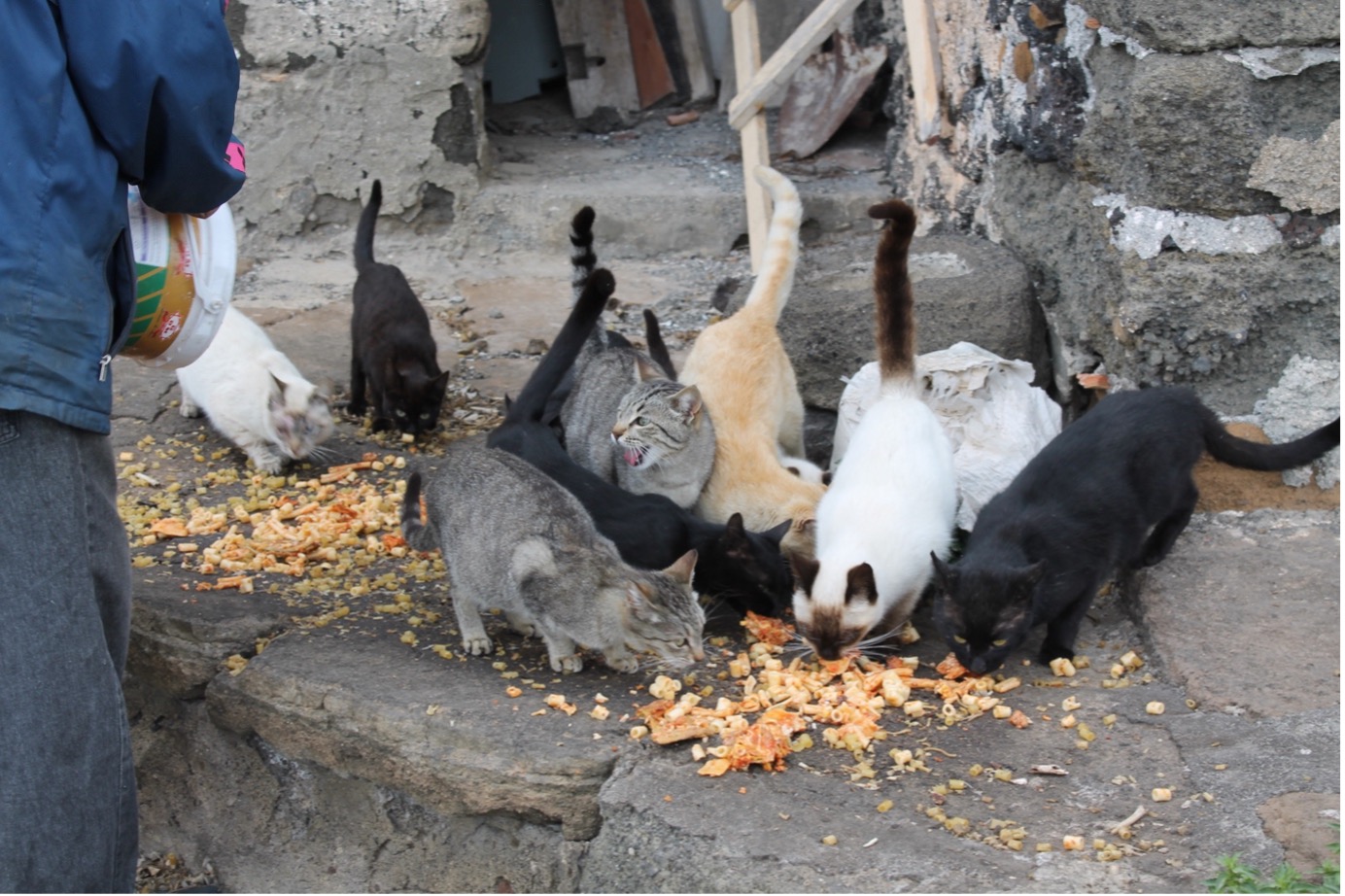
Cats being fed pasta. Image courtesy Martina Checchetti.
Moreover, in Linosa there wasn’t a veterinarian, and the closest one was in Lampedusa, (two hours by boat), so this also had an impact on the cats’ poor health conditions and reproductive status.
How do the local community view the cats; do they like them or see them as a nuisance?
The majority of the inhabitants like cats, both as companion animals and as rat and mouse controllers. They also represent one of the symbols of the island – there is a black cat painted on the wall of a house in the centre of the village. However, there are some inhabitants (a minority) that see cats as a nuisance, mainly those owning shops, particularly during the period when cats are mating, when males spray on doors and windows.
What is the impact of the cats on the indigenous bird population and also the migratory birds?
So, just to let you understand the importance of Linosa as a biodiversity hotspot, before replying to this question, I would like to say that it is situated in the southwestern Mediterranean Sea and belongs to the Pelagie Archipelago. Owing to this strategic location, it attracts many migrants, particularly passerines, where they restore the fat lost during their long flights between North Africa and Europe and vice versa. It is estimated that around 200 avian species stop here in Spring (maximum peak April-May) and 150 in Autumn (maximum peak October). Many of these species are included in the Habitats Directive (Directive no. 92/43 / EEC). Moreover, it also hosts ca. 10,000 Scopoli’s shearwater breeding pairs.

A pair of Scopoli’s shearwaters. Image courtesy of Martina Cecchetti.
The research carried out for my master’s thesis in 2014, showed that the diet of the cats roaming around the part of the shearwater colony we monitor (around 450 nests) included Scopoli’s shearwaters (16% frequency of occurrence in their scats) and we observed many events of predation upon chicks, as well as, chicks found dead showing signs of cat predation. Moreover, amongst the prey, there were numerous species of migratory birds. Cats also predated upon the endemic lizard and the big head cricket (another endemic species included in the Habitat Directive). Finally, some birdwatchers, assiduous visitors of the island, estimated around 200 birds were predated every day by the cats during the migratory peaks.
As this is an island population, is it a straightforward thing to manage the population or is it more complicated than that?
It’s really complicated for several reasons:
a) There are no proper unowned free-roaming cats in Linosa, indeed each cat can be related to an owner or a colony caretaker. So, to neuter them, you have to ask their permission, and so this has required and still does, raising islander awareness on the importance of neutering cats.
b) In our case, sterilisation depends on vets and people willing to trap cats as volunteers. When I started the cat sterilisation programme in 2015, it was in collaboration with the Public Health Authority (ASP) of Palermo, because, as I said, in Linosa there is no vet. Throughout the years, we sterilised 157 cats with them. Unfortunately, relying on the ASP vets’ availability and weather conditions, sterilisations have been carried out with no regularity and not considering the reproductive period of cats, resulting in an increased number of cats in March 2021.
This situation changed in November 2021, when our association started a collaboration with Dr Paolo Santanera, a vet from Turin who sterilised 44 cats in a few days and, with extreme professionalism, gained the respect and trust of cat owners and colony caretakers. In addition, in February 2022, our association received a contribution from Action Project Animal, as a result of a charity activity of COOP Lombardy. This support has allowed us to carry out 2 sessions of sterilisation (122 cats sterilised, around 20 visited and 4 operated on for health problems), buy traps, carriers, medicine and equipment for surgeries, as well as refund the collaborator’s expenses for travelling to Linosa. My last census counted 420 cats on the island and only 60% of them are sterilised to date, so there is still loads to do.
c) Time to carry out the census of the cats, in order to organise sterilisation and understand population dynamics.
d) Sometimes inhabitants bring cats from the mainland. A random sample of around 40 cats on Linosa tested negative for FeLV and FIV in February and November 2022. This is important to take into account when inhabitants adopt cats from the mainland or the nearest island Lampedusa, where such diseases are present.
e) Cats are really clever, and we have just 8 traps, so when in big colonies, the cats see other cats being trapped, so they do not enter.
How easy was it to engage the local population to assist with your TNR project?
It was pretty challenging, I have to be honest. Indeed, they were sceptical about neutering cats for the fear of remaining with no cats (which is impossible, but this fear is still present), it was considered unnatural (especially for males), they were worried about the cats becoming “dumb” and lazy and so being more prone to road accidents and less able to catch mice and rats. However, during the last two trapping sessions, I have been assisted by two islanders who love cats and have understood the importance of the problem. They have been provided with many kilograms of high-quality cat food for their immense help.
How often do you engage in TNR activity on the island?
Twice per year before the cat mating period, so usually February/March and October/November. But as I said, this has been possible only since Paolo became a collaborator of Berta maris, and we’ll try to do our best for keeping this schedule. Otherwise, all the efforts made will be lost.
What is the impact of neutering and a balanced diet on the cats’ predation of birds?
Well, I would say both interventions reduce the pressure on wild populations of birds. Indeed, neutered females do not need to hunt for their kittens; the density of cats is reduced and consequently the overall predation rate. Their home range is reduced, as well as their roaming activities. Imagine the distance that a male cat can cover during the mating season compared to a neutered male cat – reducing the so-called “indirect effects” on birds (it has been shown that the mere presence of the cats reduces bird breeding success up to 95%). Moreover, owners and caretakers have an economic advantage in neutering as they end up having less cats and can buy pet food instead of feeding them with leftovers (still not great quality pet food as the supermarkets there only sell low-quality cat food, but at least it is balanced). From my study in the UK, we know that food with a high-meat content reduces hunting in pet cats, so it would be advisable to deliver a better food to the cats in Linosa to further reduce predation pressure on wild birds.
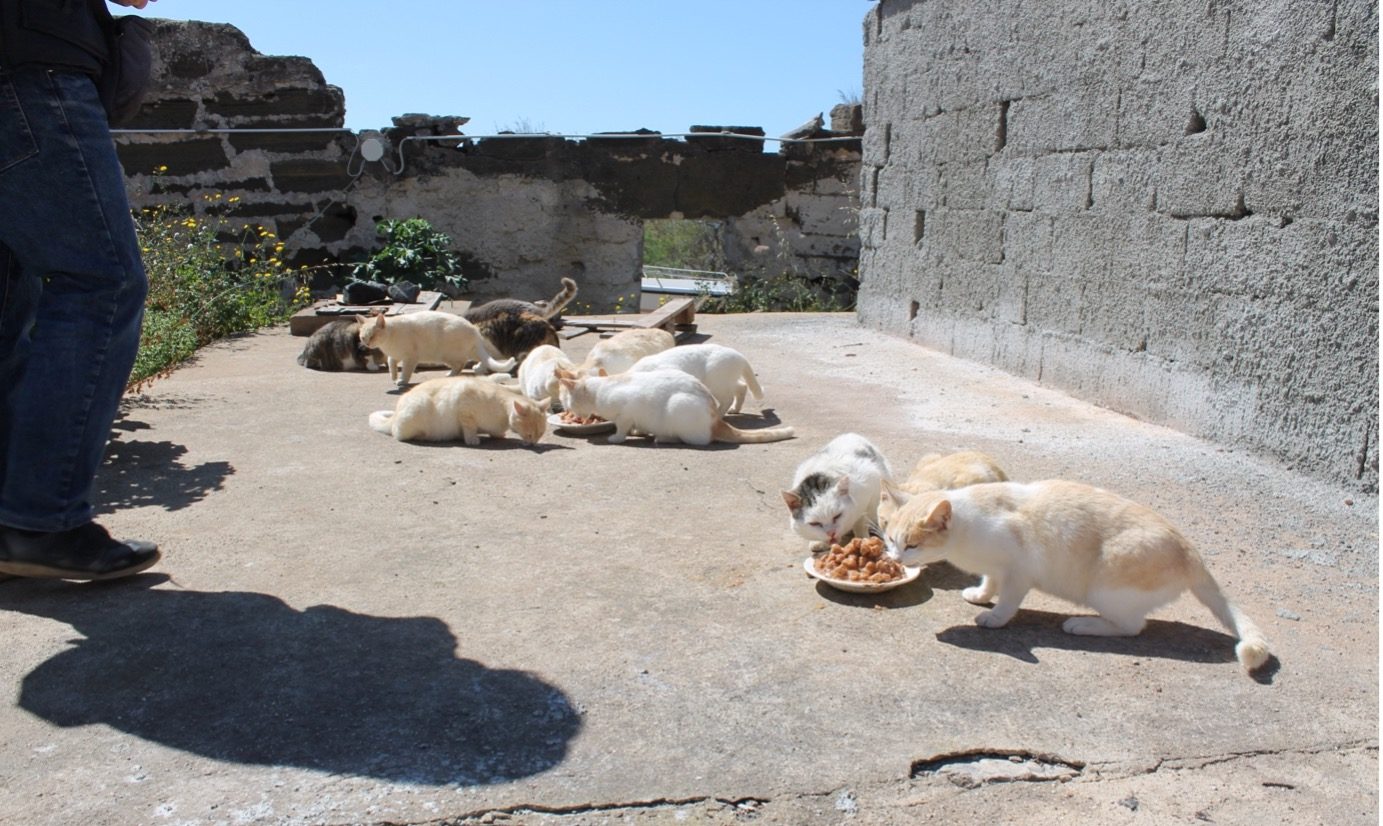
Feeding a balanced diet to the Linosa cats. Image courtesy of Martina Cecchetti.
Sometimes, we forget cats’ predation that impacts positively on our lives, for example, reducing the numbers of rats and mice. Is this relevant to Linosa?
Absolutely. The rodent population would be out of control if cats were not there. Rats are present on the island at high density (introduced by accident by humans when they first colonised Linosa) and they predate upon shearwater eggs and chicks and also represent a problem for agriculture.
Do you have any messages for people around the world working with cats on TNR projects? Maybe something you have learned from working with the cats at Linosa?
From the experience in Linosa, I would say that TNR projects are challenging projects, and to be well done they require time and expertise, so resources are fundamental (not reducing doing them as volunteering activities). Planning, continuity and effort are extremely important too. To achieve a good result, it’s vital to know the number of cats, trapping and sterilising the 90% of the population in the very first neutering sessions and then keeping it up as a maintenance activity. Having owners and caretakers on board is another essential point. It might be frustrating, especially as volunteers, but outcomes often repay the hard work.



